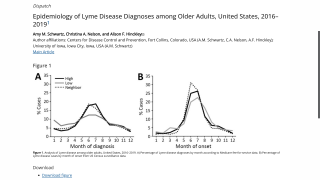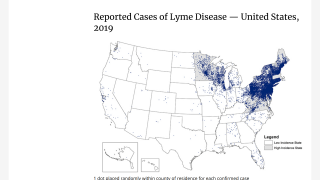Peptidoglycan May Explain Late-Stage Lyme Disease Arthritis

A Virginia Tech (VT) biochemist has discovered the cellular component that contributes to Lyme arthritis, which is the most common late-stage symptom of Lyme disease.
On June 18, 2019, Brandon Jutras, an assistant professor in the VT’s College of Agriculture and Life Sciences, said in a press release that he ‘found that as the Lyme-causing bacteria Borrelia burgdorferi multiplies, it sheds a cellular component called peptidoglycan, that elicits a unique inflammatory response in synovial fluid.
Peptidoglycan is an essential component of bacterial cell walls.
All bacteria have some form of peptidoglycan, but the form found in the bacteria that causes Lyme, Borrelia burgdorferi, has a unique chemical structure, said these VT researchers.
When the bacteria multiply, they shed peptidoglycan into the extracellular environment, because its genome does not have the appropriate proteins to recycle it back into the cell.
Peptidoglycan elicits an inflammatory response and the molecule persists in the synovial fluid, which means that our bodies continue to respond, without mounting a counter-response.
Receptors in the human immune system sense bacterial products and, depending on the individual’s genetic predispositions, may determine how strongly a patient’s body reacts to peptidoglycan.
Clinical samples included in this study were obtained from patients that had confirmed cases of Lyme disease but did not respond to oral and/or intravenous antibiotic treatment.
The presence of peptidoglycan in these patients’ synovial fluids may explain why some people experience symptoms of late-stage Lyme disease in the absence of an obvious infection.
This means the usual antibiotic treatments for Lyme disease would no longer be helpful.
“This discovery will help researchers improve diagnostic tests and may lead to new treatment options for patients suffering from Lyme arthritis,” said Jutras, the lead author on the study.
“This is an important finding, and we think that it has major implications for many manifestations of Lyme disease, not just Lyme arthritis.”
“We can actually detect peptidoglycan in the synovial fluid of the affected, inflamed joints of patients that have all the symptoms of Lyme arthritis, but no longer have an obvious, active infection,” Jutras said.
The next phase of Jutras’ work is to use methods to destroy the peptidoglycan or intervene to prevent a response, which could get rid of Lyme disease symptoms.
Jutras predicts that with either therapy patients would start recovering sooner.
“We are interested in understanding everything associated with how patients respond, how we can prevent that response, and how we could possibly intervene with blocking therapies or therapies that eliminate the molecule entirely,” Jutras said.
Recent Lyme disease vaccine news:
- Lyme Disease Vaccine Candidate VLA15 Dosage Levels Approved
- Dogs Are Man’s Best Lyme Disease Alarm
- Asian Longhorned Ticks Are New And Spreading Fast
These findings were published in the Proceedings of the National Academy of Sciences.
Lyme disease is the most reported vector-borne disease in the USA. The Centers for Disease Control and Prevention (CDC) estimates that approximately 300,000 people are diagnosed with Lyme disease annually.
Over the past two decades, 7 new tickborne germs that can cause illness have been identified in the USA: Borrelia mayonii, Borrelia miyamotoi, Ehrlichia ewingii, Ehrlichia muris eauclairensis, Heartland virus, Rickettsia parkeri, and Rickettsiaspecies 364D.
A new tick species, Haemaphysalis longicornis (the Asian longhorned tick) has been identified for the first time in the United States. In other countries, bites from longhorned ticks can make people and animals seriously ill.
As of April 9, 2019, no harmful germs have been found in the ticks of this species that have been collected in the USA.
While not all ticks spread the same germs, ticks can be found in every state.
However, reported cases of Lyme disease, anaplasmosis, babesiosis, and Powassan virus disease are concentrated in the Northeast, mid-Atlantic, and upper Midwest, with pockets of lower risk along the West Coast.
The range of the tick that transmits Lyme disease also is expanding, says the CDC.
Our Trust Standards: Medical Advisory Committee

























